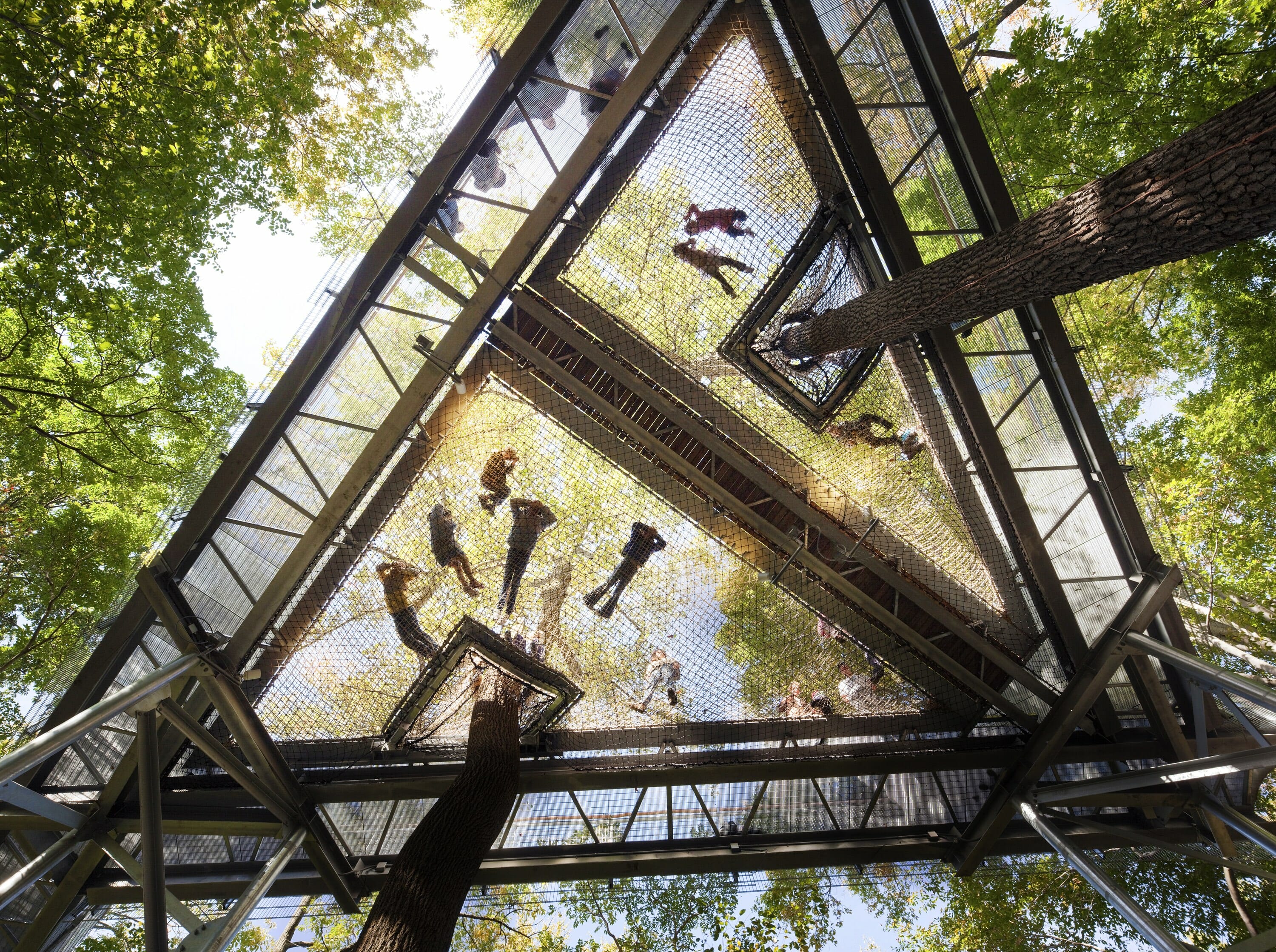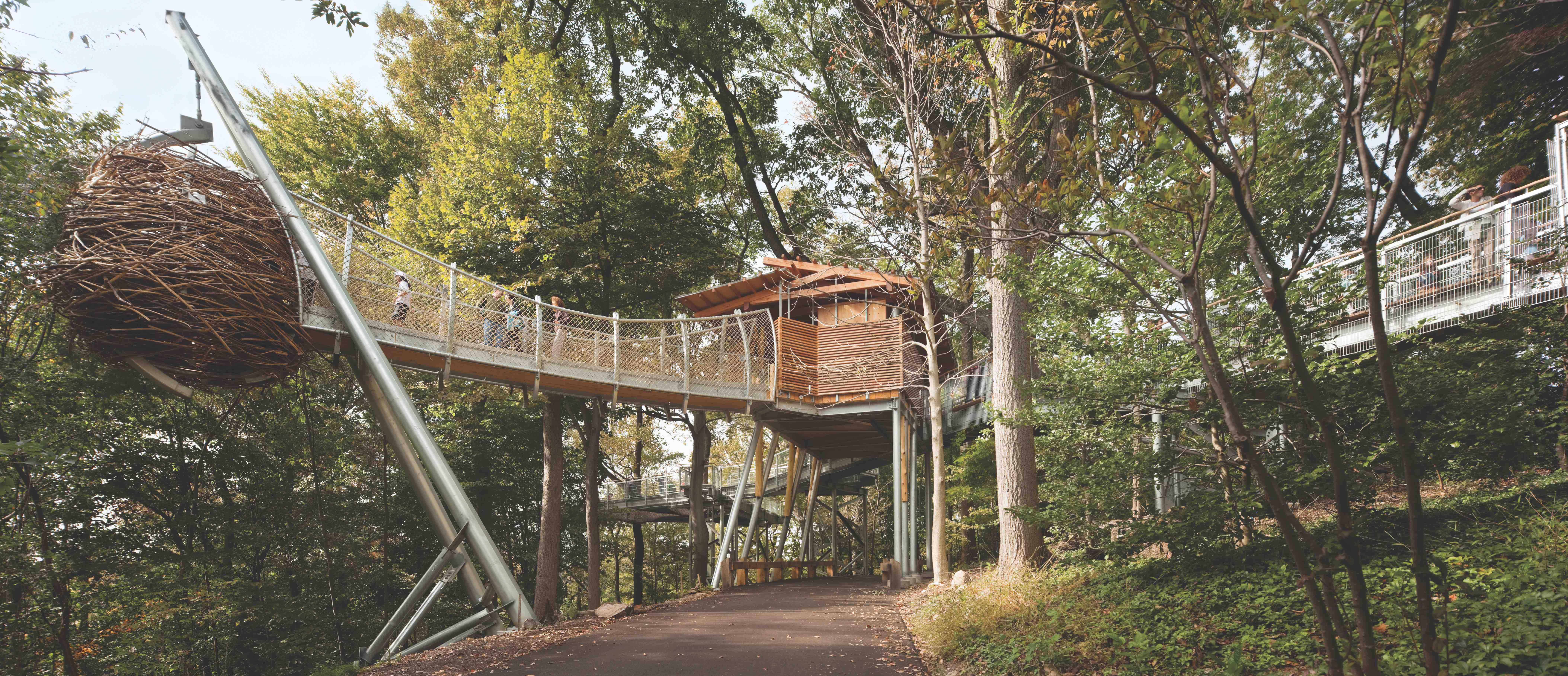Out on a Limb
The Tree Canopy Walk at the Morris Arboretum
For the Morris Arboretum, we took our design cues from the forest itself: oriole nests, pine cones, and tree architecture. We gained inspiration from human structures, too, such as mining poles, fire towers, and high-voltage transmission towers.
Images courtesy of Metcalfe

By Aaron Goldblatt, Metcalfe
The journey to design a walk through the trees began when a supporter of the Morris Arboretum at the University of Pennsylvania presented a problem to Paul Meyer, the Arboretum’s Executive Director. Her 12-year-old granddaughter, like most kids that age, would rather do almost anything other than visit an arboretum. She would rather hang out at a friend’s house than walk through plants and trees. This got Paul thinking – how could the Arboretum become something teenagers might actually want to visit? What can pry kids away from screens and other distractions to a place that creates genuine connections between people and nature?
Previously, Paul had seen a prototype of a tree canopy walkway at Kew Gardens in London. He immediately recognized how the surprising, elevated perspective it offered – one typically reserved for squirrels or arborists – had a transformational impact on the experience of the forest. Our experienced design team at Metcalfe joined the project just as the notion of bringing a canopy walk to Philadelphia had taken hold.
The mission of the Morris Arboretum is to promote an understanding of the relationship between plants, people, and place. By shifting the equation – putting people in a new and somewhat scary place high in the trees – we intended for them to look at the plants differently and notice things they had not before. The arboretum has been here since 1887 and was once barren with poor soil, but over the years became a flourishing place to learn, to relax, and now to play.
Collectively and consciously, to give visitors an opportunity to experience the trees in ways they could never do otherwise, we set a course to play. We thought combining play with education would improve attendance to the arboretum and make the experience of visiting all about seeing the world from a new vantage point. We created a big idea for the project that would guide our thinking throughout the course of the design process: We need trees and the urban forest needs our care. People will love trees (and will care for them) if they can freely play among them.
For a playscape to work there is a critical balance to strike between familiar and novel. There must be enough familiarity with the players to give them the confidence to enter and engage with the environment and enough novelty to draw them in and keep them interested. For the tree canopy walk and the Morris, the most familiar element is the trees. Everyone has an idea of what a tree is. It has leaves. It’s tall. Birds and other animals live among its branches. But few of us have the pleasure of seeing a tree from the vantage point of the canopy. We’ve not had the opportunity to view the ground the way a bird can when perched up high. That’s the novelty that proves irresistible to visitors and engages them in the experience.

Application and Experience
For the Morris Arboretum, we took our design cues from the forest itself: oriole nests, pine cones, and tree architecture. We gained inspiration from human structures, too, such as mining poles, fire towers, and high-voltage transmission towers.
We also looked closely at traditional Chinese garden design. We employed zigzagging wooden boardwalk paths, about 450 feet in length with a series of “moon gates,” round openings that mark points of entry and transition. This unique path delivers a generous experience over a small journey.
The single-entry path ends at a beautiful tea house then divides into two paths: one leading to a colossal bird’s nest, with climbable robin’s eggs inside, and the other to a pair of large horizontal, hammock-like nets, called the Squirrel Scramble, that embraces several specimen trees just below their canopies.
The list of design rules we adopted included normal project demands like schedule and budget constraints. The project needed to be as pragmatic as it was ambitious. But an arboretum is also a museum of trees, and we could not harm the collection. The foundation system we designed ensured that no significant damage would occur to the roots of the trees immediately surrounding the support structure of the canopy walk. Steel, rather than wood, was selected as the primary structural material in order to differentiate between the walkway and the trees and to reduce its interference with the surrounding area. The structure could not touch the trees and had to give them wide berth to allow them to sway uninhibited.
What we did not plan for was the intense social experience of the people seated along the edges of the nets, dangling their feet into the rope lattice. Strangers talk to each other about what they see. Parents laugh as their children roll around on the suspended grid. Teenagers let go and yell as they tumble around freely. The experience generates conversation, smiles, and outright laughter.
Measuring Success
I am convinced that the heady combination of perceived risk, genuine novelty, and the beauty of the surrounding forest delivered the gold standard in design for social spaces. Here is a place of open-ended play with very little instructions for visitors on how to interact. It has been a huge success, in revenue, attendance, and publicity.
In 2010 the American Alliance of Museums recognized the Morris Arboretum with the Excellence in Exhibitions Award.
The success of the Morris Arboretum canopy walk was evident in the standard metrics that public institutions use to chart their development: in the decade since the project opened, they have remained at historic attendance levels. For most of us involved, it’s more than the numbers. The Morris’s staff holds their meetings in the net – it’s even making their workdays more creative and playful. The stories that we hear are how we can truly understand the project’s impact.
I visit the arboretum often, sometimes with groups of family and friends and sometimes alone, just to check in. Without prompting and without fail, sounds of joy accompany every visit as people make new discoveries about the trees and themselves.
A two-year-old spills from the walkway down onto the net, laughing, rolling, then becoming serious, peering through the ropes down to the ground 50 feet below. His father stands in awe at the edge, wondering how he’ll muster the courage to join his son.
A seven-year-old boy looks up at me and says, “I’ve waited my whole life for this!” He then launches himself out into the net.


From Design Museum Magazine Issue 009
What is Play?
As an exhibit designer, I have spent the better part of 30 years looking closely at play; what causes it, what stops it, and what sustains it. I’m no closer to a definition of it than academic scholars who take a formalized approach to its study. But there are some characteristics of this fundamental behavior that are found consistently across all age groups, developmental levels, physical abilities, even across many animal species who apparently play. These include:
Rules
All play requires rules. Players need to agree to the boundaries within which the play can occur. Those rules can change, and often do, but if the players don’t agree with the changes, the play ends. In the case of the Morris Arboretum, as in all of our projects, those rules include safety. It’s understood the players will not be harmed by the environment, even if there is a perception of risk, which brings me to the second characteristic…
Risk
There must be some element of risk in the play or there is no room to genuinely play. Everyone has a different level of acceptable risk and every play opportunity presents different kinds of risk. Rock climbers looking up at El Capitan in Yosemite assess their risk based on numerous factors, including their experience, available equipment, and weather. Kids process risk too and part of playing is learning to assess and make decisions based on risk.
Pleasure
If there is no promise of pleasure, of having fun, and feeling joy, there can be no play.
